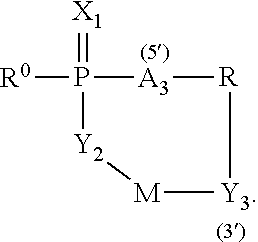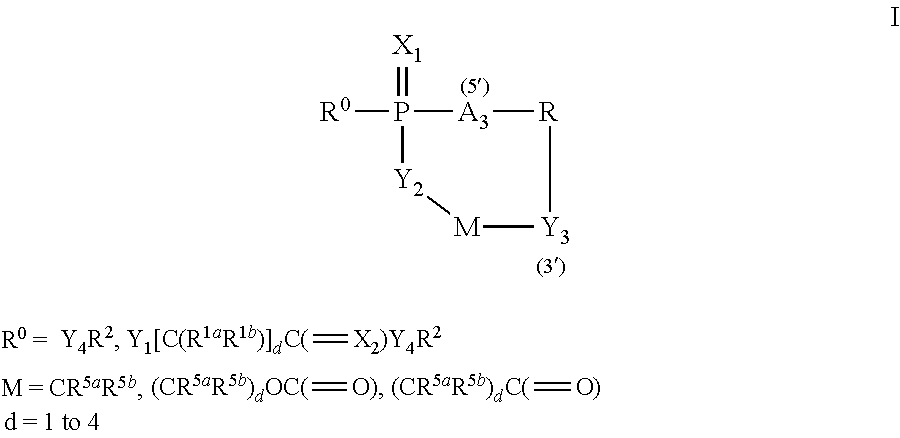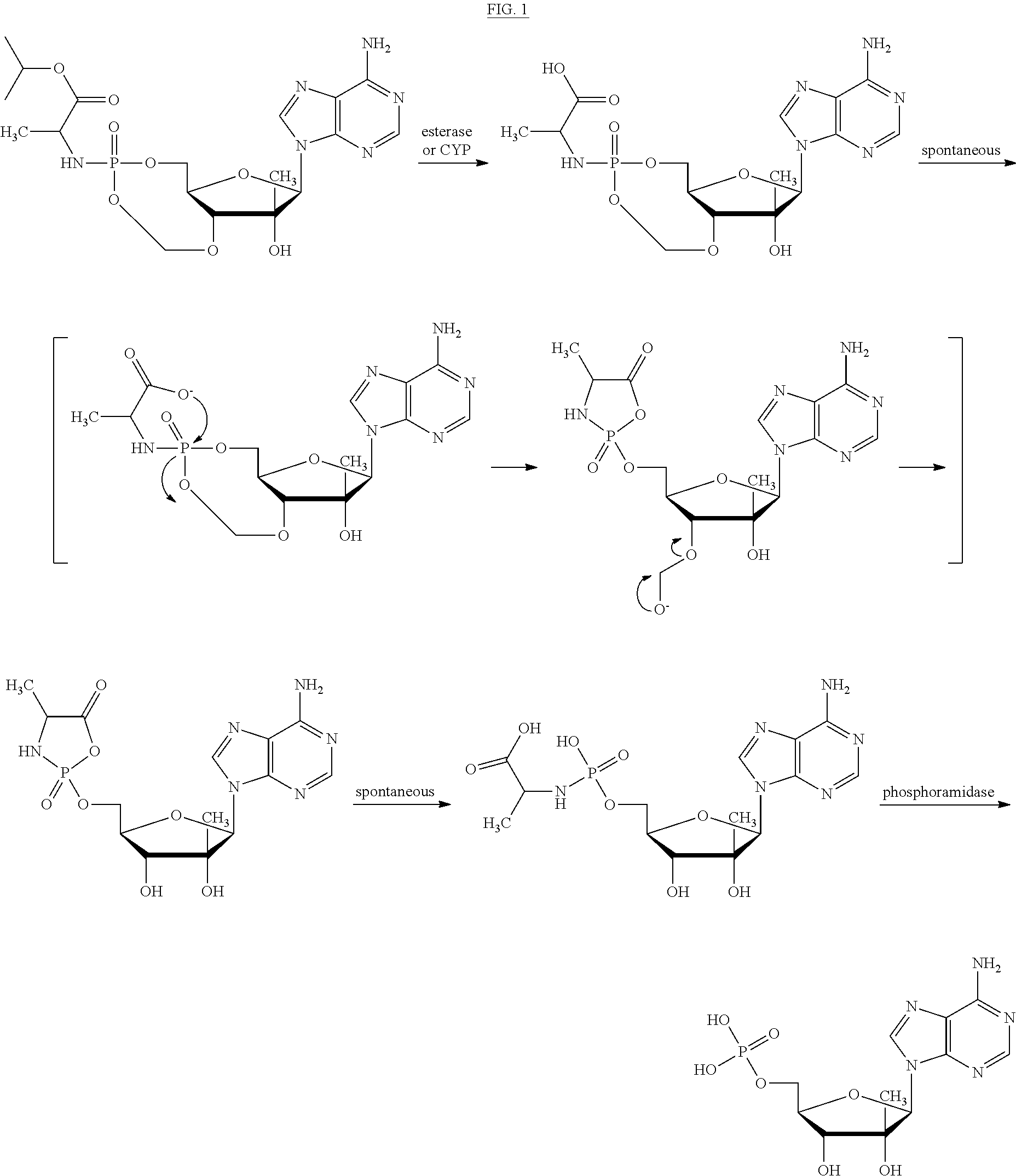Bridged-Cyclo-ProTides as Prodrugs of Therapeutic Nucleosides and Nucleotides
a technology of bridged cycloprotides and nucleosides, which is applied in the field of compounding, can solve the problems of lack of therapeutic effectiveness of many nucleoside analogs, poor stability, and inefficient metabolic activation, and achieve the effects of reducing the toxicity of tissues such as the gastrointestinal tract, reducing the optimal dose amount, and inhibiting the targeted enzymes
- Summary
- Abstract
- Description
- Claims
- Application Information
AI Technical Summary
Benefits of technology
Problems solved by technology
Method used
Image
Examples
example 1
Compound 1
Preparation of (2S)-isopropyl 2-(((6aR,8R,9R,9aR)-8-(2,4-dioxo-3,4-dihydropyrimidin-1(2H)-yl)-9-fluoro-9-methyl-4-oxidotetrahydro-6H-furo[3,2-f][1,3,5,2]trioxaphosphocin-4-yl)amino)propanoate (Scheme 1-A to C)
[0331]Method A (Scheme 1-A):
[0332]Preparation of Intermediate 1-1
[0333]In a round bottom flask, disodium p-nitrophenyl phosphate hexahydrate (0.5 mmol, 1 mol / eq) and isopropyl L-valinate hydrochloride (3 mol / eq) are dissolved in a mixture of tert-butanol (9 ml) and H2O (2 ml). A few drops of triethylamine (Et3N) are added to the solution to facilitate dissolution. An appropriate amount of N,N′-dicyclohexylcarbodiimide (DCC) (3 mol / eq) is dissolved in 1 ml of tert-butanol and is dropwise added to the reaction mixture. The reaction mixture is refluxed carefully for 3-4 h while stirring. The progress of the reaction is monitored by TLC (i-PrOH:NH3:H2O). Upon completion, the reaction mixture is cooled down and the solvent is removed by rotary evaporation. The product is i...
example 2
Compound 2
Preparation of isopropyl 2-(((6aR,8R,9R,9aR)-8-(6-amino-9H-purin-9-yl)-9-hydroxy-9-methyl-4-oxidotetrahydro-6H-furo[3,2-f][1,3,5,2]trioxaphosphocin-4-yl)amino)propanoate (Scheme 2-A and B)
[0350]Method A:
[0351]Preparation of Intermediate 2-1
[0352]In a dry flask, to N-(9-((2R,3R,4R,5R)-3,4-dihydroxy-5-(hydroxymethyl)-3-methyltetrahydrofuran-2-yl)-9H-purin-6-yl)benzamide (1 mmol, 1 mol / eq) in anhydrous DMF (5 mL) stirred at 0° C. under nitrogen is added di-t-butylsilyl ditriflate (1.1 mol / eq) dropwise. The resulting mixture is stirred at the same temperature till completion as showed by TLC analysis. The reaction is diluted with EtOAc (50 mL), and washed with H2O (50 mL×3). Then, it is dried over anhydrous MgSO4, and concentrated under reduced pressure. Purification by silica gel column chromatography (DCM / MeOH) affords intermediate 2-1.
[0353]Preparation of Intermediate 2-2
[0354]In a dry flask, intermediate 2-1 (1 mmol, 1 mol / eq) is dissolved in DCM (10 mL), and then DIPEA (1...
example 3
Compound 3
Preparation of isopropyl 2-(((6aR,8R,9S,9aS)-8-(6-amino-2-fluoro-9H-purin-9-yl)-9-hydroxy-2,2-dimethyl-4-oxidotetrahydro-6H-furo[3,2-f][1,3,5,2]trioxaphosphocin-4-yl)amino)propanoate (Scheme 3)
[0375]Preparation of Intermediate 3-1
[0376]In a two neck flask, fludarabine phosphate (0.5 mmol, 1 mol / eq) and isopropyl L-valinate hydrochloride (3 mol / eq) are dissolved in a mixture of tert-butanol (9 ml) and H2O (2 ml). Triethylamine (10 mol / eq) are added to the mixture to facilitate dissolution. An appropriate amount of N,N′-dicyclohexylcarbodiimide (DCC) (3 mol / eq) is dissolved in 1 ml of tert-butanol and is dropwise added to the reaction mixture. The reaction mixture is refluxed while stirring. The progress of the reaction is monitored by TLC (i-PrOH:NH3:H2O). Upon near completion, the reaction mixture is cooled down and the solvent is removed by rotary evaporation to provide crude intermediate 3-1.
[0377]Preparation of Compound 3
[0378]To a round bottom flask containing interme...
PUM
| Property | Measurement | Unit |
|---|---|---|
| temperature | aaaaa | aaaaa |
| pH | aaaaa | aaaaa |
| pH | aaaaa | aaaaa |
Abstract
Description
Claims
Application Information
 Login to View More
Login to View More - R&D
- Intellectual Property
- Life Sciences
- Materials
- Tech Scout
- Unparalleled Data Quality
- Higher Quality Content
- 60% Fewer Hallucinations
Browse by: Latest US Patents, China's latest patents, Technical Efficacy Thesaurus, Application Domain, Technology Topic, Popular Technical Reports.
© 2025 PatSnap. All rights reserved.Legal|Privacy policy|Modern Slavery Act Transparency Statement|Sitemap|About US| Contact US: help@patsnap.com



